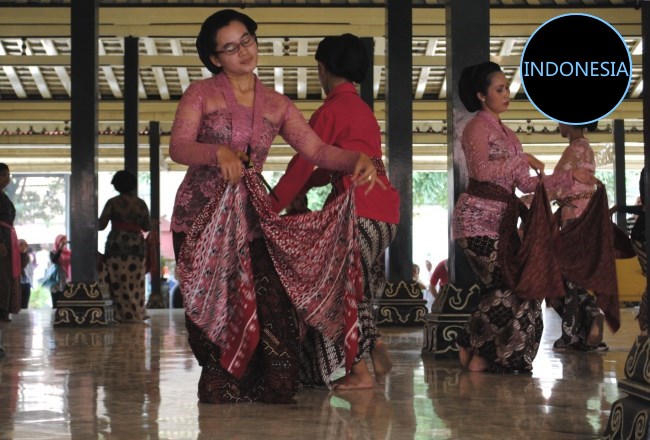Yogyakarta: Sultan’s Palace and Saman Tari

Following the disaster of our first trip we tried again to visit the Yogyakartan Sultan’s Palace, this time on a Sunday, in the hope of seeing some traditional Javanese dance.
It’s now more than two months since I first experienced traditional Javanese music and dance and I still can’t seem to get the sense of it, the sound, the movement, the eerie hauntedness of it, out of my head. I fell hard for Javanese culture then, the dance was so unlike anything I had ever seen before.
There weren’t that many people gathered around, a few tourists, a few locals and an overwhelming majority of school children. We sat on the cool tiles at the edge of the performance area, knowing that to see this performance, that was a matter of ritual and not staged purely for the benefit of tourists, was a privilege.
Javanese dance looks like a recording being played in slow motion. It’s like Tai Chi, constant, fluid arching and stretching of torso and limbs and there’s something unsettling and not quite human about the way they move their heads, the strange angles, eyes open wide but faces blank like clockwork dolls. You’d think it was quite easy, the slow-mo theatrics of it, if it wasn’t for the sight of the dancer’s foot, toes painfully twisted to hold her pose, tendons in the top of her foot like violin strings ready to snap or the drip of sweat starting at her hairline and running down her perfectly made up face.
It lasts a long time. The musicians, singers, dancers, all performing without pause for what must be around 30 minutes in measured time, but for me, mesmerised, taken out of time in a way that only art is able to take us (well, maybe sex and narcotics too), it felt like a moment and an eternity.
Afterwards we walked to Taman Sari, the ‘Water Castle’. The Water Castle is a perfect example of the hedonistic perks of being royalty. Used by the Sultan since the mid 1700’s, the grounds and swimming pools offered a private space where the sultan could be alone with his harem. Young women and girls were culled from local villages and after hours of preparation would bathe in the open air pools with the Sultan watching from a creepy tower choosing which girl would accompany him that night.
As a general rule I always try to use a guide when visiting architectural ruins, without the stories I feel like I’m just looking at bricks, so we took up the offer of an English-speaking and were glad we did. What’s incredible about this place, not just the Water Castle but the whole Kraton complex is how the Kampung Sari (the village within the Kraton’s walls) still live in buildings that were once part of the castle and have recently been given UNESCO local heritage status. They actually live under the Sultan’s jurisdiction. Can you imagine?
The queen (the Sultan’s mother) lives in a little house just outside the castle and, according to our guide, banned television because she didn’t like the noise. There are no telephone lines here but she has her own little royal communications tower so she can order taxis. I’m not kidding. Currently, the guides at Taman Sari take turns sleeping in some of the more important buildings, such as the Sultan’s bedroom to protect them at night. Most of the wood and metal fixings that could be removed already have been but the guides hang around, chasing away young couples from the village looking for a bit of privacy. Locals still stage a cock fight each morning in one of the castle’s courtyards.
According to our guide, as soon as funding is received from UNESCO to begin a renovation project, all of the residents of historically significant buildings will be evicted. Where they’ll go he couldn’t say. Another village displaced to encourage tourism. Another time capsule prised open



